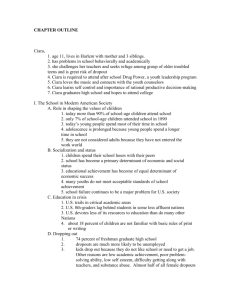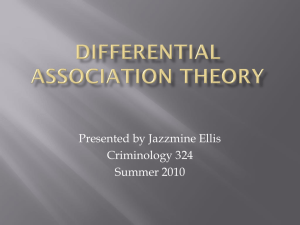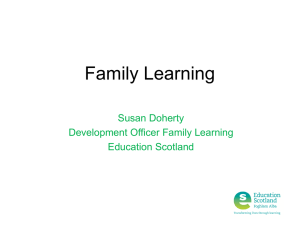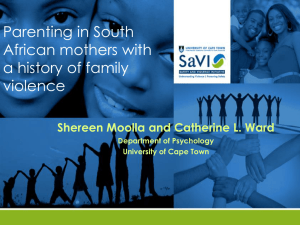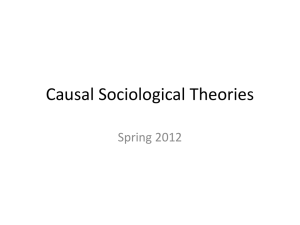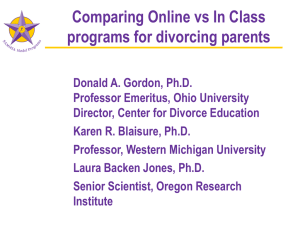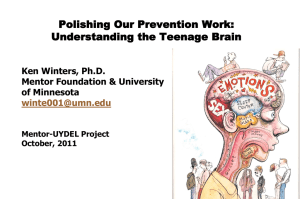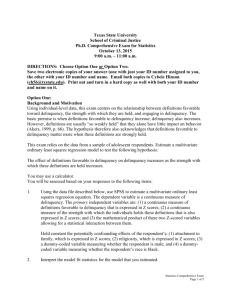Chapter 10--Family
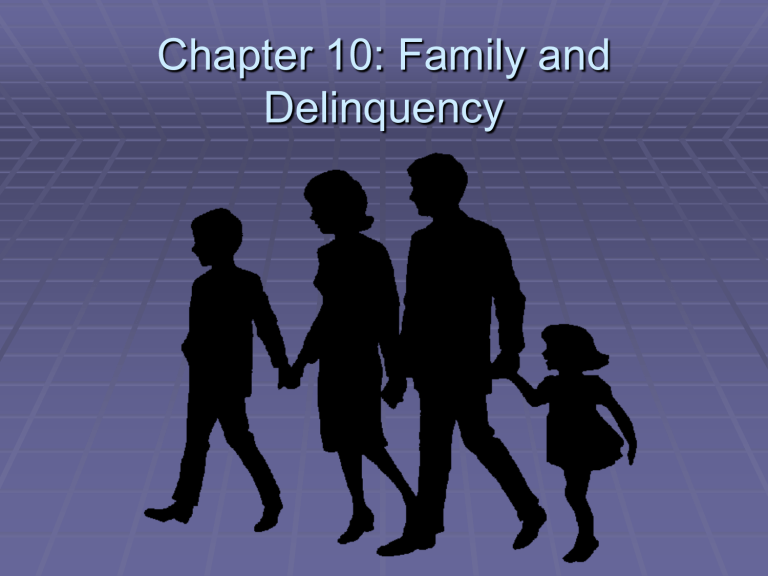
Chapter 10: Family and
Delinquency
•
A. Introduction - Family is the most critical social institution and this presentation will cover:
a. Socialization
b. The instillation of moral values into children
c. Regulation of Sexual activity
d. Nurture
1) Traditional functions of the family
2) The changing family (The rise of single parent families)
a. Single parent families
b. The effects of divorce on delinquency
c. The plight of latchkey children
3) The effects of parenting
a. Parenting skills
b. Parental supervision
c. Parenting styles
d. Parental attachment
e. The maltreatment of children
B. The traditional functions of the family
1) The socialization of children
a. Socialization is the process through which children learn the ways of a particular society or social group so that they can function within it (i.e. the attitudes, behaviors and social roles deemed as appropriate by already socialized individuals —typically parents and other members of the family)
i. The family is the most important social unit in a child’s life since it is the first social unit that a child encounters
ii. However, the family unit does not exist in a vacuum; rather, it exists within a larger social and cultural context, reflective of many characteristics (i.e. political, religious)
iii. Therefore, a child’s process of socialization is somewhat selective
2) The instillation of morality into a child
a. One of the most important aspects of socialization is the inculcation of moral values into a child (“rights and wrongs” and the development of good habits)
b. Teaching and setting examples are crucial to this process
c. Child psychologist Robert Coles stresses the golden rule, respect for others, devotion to one’s family and friends and the development of a moral compass of sorts
e. Emily Durkheim argued that the integrative function of religion is crucial for maintaining a sense of order in a child’s life
i. When parents view religion as important and actively involve their children in religious practices and beliefs, their inclination toward delinquency will be significantly reduced
d.
The Children’s Defense Fund (CDF) advocates a “good start” for every child and the inculcation of ‘positive’ moral values at an early age
f. According to Bruce Chadwick and Brent Top, “the more religious a person is, the less likely he or she will be to participate in delinquent or criminal behaviors”
g. There have been numerous studies to test whether there is a correlation between religiosity and reduced rates of delinquency
i. Though many studies show that a strong attachment to a religious belief system decreases delinquency (see Bryon Johnson study), researchers such as Travis Hirschi argue that no such link exists
3) Reproduction and regulation of sexual activity
a. Society’s norms regarding sexual activity are often taught to children via the family unit
i. From the family, children learn about the consequences of sexual activity as well as appropriate behavior
4) Security
a. Besides providing shelter, food and clothing, the family provides for the physical and emotional security of its members as well
b. Obviously, no family is perfect and may not be successful in achieving every single one of the aforementioned goals
i. Families may transmit values that promote violence or criminality which may hinder the development of a positive self concept among its members
ii. Many families do not teach proper sexual conduct and many families fail to provide proper material, physical and emotional security to its members
C) The changing family
1) The institution of family has undergone dramatic changes in America in the past few decades
a. The U.S. Census Bureau’s Current Population Report cites that in 1980, 85 % of children under age
18 lived with both mother and father
i. By 2000, this number was only 71%
ii. Of single parent households, 84 % of children live in households headed by women, while 16 % live in households headed by men
iii. The number of children living with a parent or parents who are cohabitating (to live together in a sexual relationship, especially when not legally married) has also increased
2) Single parent families
a. Single-parent families or families composed of children and one parent who is divorced or widowed or who was never married, have been on the rise in the last few decades
i. Sara McLanahan and Linda Gordon point out the startling fact that only 5 % of children lived in single parent households in 1900 (and this was typically due to the death of a spouse)
ii. Today, that number has risen well into the double digits
b. Teen pregnancies also contribute to single-parent households
i. In 1999, the birth rate for teenagers ages 15-17 was 28.7 per 1000, down from the high time high in 1991 of 38.7 per 1000 according to U.S. department of health statistics
c. Single parent families are not distributed evenly among racial and ethnic groups according to the Federal Interagency Forum on Child and Family Statistics (FIFCFS)
i. 65% of black children are being raised by a single parent
ii. 37% of Latino children “”
iii. 23% of white children “”
d. The poverty rate for single parent households is five times higher than for two-parent families (9% of children in two-parent families live in poverty, while 46% of children in female headed families are at or below the poverty level)
i. Another disparity is that while only 12% of black children living with their married parents were in poverty in 1998, 55% of black children of female led households lived in poverty in the same year according to
FIFCFS statistics
e. Teenage mothers are also three times as likely to drop out of school and will earn less money than unmarried mothers who have their first child in their twenties
i. Travis Hirschi urges society not to lay the blame on the teenage mother, but rather on the fact that her children will be more likely to be delinquent without a father figure
f. What about the effects of pregnancy on teen fathers?
i. Many studies have shown that boys who become teenage fathers are more likely to engage in a variety of other problem behaviors than non-fathers
ii. Since teen fathers are unlikely to be financially or emotionally secure, they are not likely to be a strong role model
iii. Dead-beat dads are an enormous problem in the United States
g. Children in single-parent families also seem to be more prone to deviant behavior
i. Jeffery Grogger cites the fact that the sons of adolescent mothers are nearly three times more likely to be incarcerated at some point in their 20’s than children born to single-parent mothers in their 20’s
3) The effects of single parent households on delinquency
a. According to Michael Rutter, even though relations between families may initially improve after divorce, the breaking up of a family by divorce is significantly more likely to have adverse effects on a child than the death of one of the parents
b. The National Center for Health Statistics reports that each year, about 2% of all married couples
(about 1.2 million families) get divorced
i. Children who have experienced the anxiety of seeing their parent(s) go through multiple divorces are likely to report higher levels of depression
ii. These children are likely to also experience troubled marriages of their own or strained relationships later in life
c. Research by Ann Goetting reinforces the notion that children from single-parent families are more likely to become delinquent than children from two-parent families
i. Once again, there has been mixed results in this particular class of research
d. Is the quality of the parent-child relationship more important than single-parent families? (Nurture versus Structure)
i. There has been a large body of evidence to support this contention
ii. Mark Zimmerman and colleagues report that regardless of family structure, emotional support trumps all
4) The impact of divorce on children
a. A study conducted by Mavis Hetherington finds that in the year following a divorce, children are likely to suffer from psychological distress
i. But, these children cope better in the long run compared to children in intact families where the parents do not get along
b. Divorce may produce a phenomenon called ‘family wars’ in which a child is caught in the middle between relatives and friends of their split up parents who ‘pick sides’
c. Longitudinal studies dealing with single parent, female-led households, such as one conducted by Judith Wallerstein and Joan Kelly, find that children initially go through a period of 18 months in which they experience a deteriorating relationship with their mother while she readjusts to a new lifestyle
i. After 18 months, the child-mother relationship begins to heal
ii. However, the 5 year mark has shown increased signs of anger and depression among these same children in many cases
d. Court ordered visitations
i. Do these help or harm the children who are forced to be “rotated” between their divorced parents?
5) The issue of latchkey children
a. The number of Latchkey children or children who regularly care for themselves without adult supervision after school or on weekends, has been increasing in the last few decades
(about 12% of children ages 5 to 12 and 41% of children age 12-14 spend a significant amount of time unsupervised while their parents are at work)
i. Since these children have less supervision, they are more likely to engage in delinquent behavior
ii. Studies undertaken by Jean Richardson found that students who spend more than 11 hours a week unsupervised after school are twice as likely to use tobacco, alcohol, and marijuana as children who were supervised after school
iii. Interestingly enough, studies conducted by Jay Belsky find that children who spend too much time in day care may be subject to behavioral problems in the future (Are daycares iatrogenic?)
b. Why the recent increase? A changing social environment
i. Most women participate in the labor force today; ¾ of married women and 79% of single mothers who are employed have children between the ages of 6 and 17
ii. Is there a connection between women in the workplace and delinquency?
iii. Once again, ‘studies have produced mixed results’
c. Matthijs Kalmijn reports that mothers who work in higher-status jobs have positive educational effects on their children (their children are likely to succeed in secondary education and beyond)
d. Similarly, Jay Belsky and David Eggebeen find that there does not seem to be a direct correlation between behavior problems and the employment status of mothers
e. Studies conducted by Travis Hirschi have yielded similar results, and at best find only a weak link between working mothers and delinquency
i. However, the ‘jury is still out on this one’
D. Parenting in families
1) Parenting skills
a. Effective parenting involves many things and is not ‘automatic’
i. Parents often become upset or frustrated with a child who consistently gets into trouble
ii. Over time, a parent may simply be unwilling to exercise reasonable parental authority and become jaded with respect to their responsibility of raising a child
iii. In fact, research by Gerald Patterson has found that parents often become tolerant of certain types of deviance and may be inadvertently encouraging it
b. According to James Snyder and Gerald Patterson, parents may participate in two unhealthy types of disciplinary styles: enmeshed and lax
i. Enmeshed – overly inclusive in what is defined as problematic behavior (authoritarian)
ii. Lax – under inclusive in what is defined as problematic behavior (Indifference)
iii. To prevent themselves from falling into one of these categories, parents must work on their problem solving and negotiating skills when talking with a child to prevent violence and to ‘break the cycle’ of leaning to one of these two extremes (lax or enmeshed)
c. Travis Hirschi strongly criticizes this approach for 4 major reasons
i. The parents may not care for the child’s welfare in the first place
ii. Parents may not have the time or energy to monitor the child’s behavior
iii. They may accept behavior that others define as deviant
iv. The Parents may not have the ‘spine’ to punish their children
d. Are programs such as the ones recommended by the Office of Juvenile Justice and
Delinquency Prevention effective?
2) Parental Supervision
a. Patterson also argues that setting boundaries, house rules, curfews, etc. are all essential in the up-bringing of a child
i. “Good supervision…. indirectly minimizes the adolescents’ contact with delinquency —promoting circumstances, activities and peers
ii. Research by Sung Jang and Carolyn Smith contends that parental supervision and delinquency are reciprocally related (though parental supervision may deter delinquency, the impact of supervision may vary
—or even weaken—as a child matures)
iii. In summary, positive parenting is a combination of an active involvement in a child’s life, the instillation of norms and values and positive feedback when a child behaves as desired
3) Parenting Styles
a. Diana Baumrind (child psychologist) believes that there are two critical aspects of parent’s behavior toward children: Responsiveness and Demandingness
i. Responsiveness – the degree to which parents are supportive of the needs of their children
ii. Demandingness
– the extent to which parents demand age-appropriate behavior from children
b. Furthermore, Baumrind postulates that parents will vary on each dimension and can fall under one of the following categories:
i. Authoritative parents – Parents who are warm but firm; they set standards of behavior for their child and highly value the development of autonomy and self-direction
ii. Authoritarian parents – Parents who place a high value on obedience and conformity, tending to favor more punitive, absolute, and forceful disciplinary measures
iii. Indulgent parents – Parents who are more responsive, accepting, benign, and passive in matters of discipline and place few demands on their child
iv. Indifferent parents – Parents who are rather unresponsive to their child and may, in extreme cases, be neglectful
c. In a separate study, Elijah Anderson described the parenting styles of inner-city black families in a much different framework
i. Decent families – According to Anderson, these types of families are characterized by a concern for the future and a work ethic aimed at achievement (a patriarchal structure is also very important in this type of family)
ii. Street families – Characterized by a deep resentment of the system that is
‘designed to hold them down’ these families are more likely to socialize aggressive values and a ‘survival of the fittest’ attitude into their children
4) Parental Attachment
a. Through ‘emotional closeness’ parents often influence the behavior of children
i. Research supports the notion that the closer a child is with their parent(s), the less likely they will be to engage in deviant behavior
ii. Research conducted by Randy LaGrange and Helen White found that parental love may reduce delinquency in adolescents because it is something that children do not want to lose
iii. A lack of communication between children and their parents can also lead to juvenile delinquency
5) Maltreatment of Children
a. Maltreatment , or the severe mistreatment of children, including physical and sexual abuse, physical neglect, lack of supervision, emotional maltreatment, educational maltreatment, and moral-legal maltreatment, is particularly prevalent in more rigid and authoritarian families
i. In response to such mistreatment, a child is likely to develop a sense of powerlessness leading to harmful adaptations to this abuse such as delinquency (Once again… are authoritarian parent’s attitudes with respect to disciplining their children iatrogenic?)
ii . Maltreatment is a serious issue and in 1999, about 3 million cases of child abuse and neglect were reported in the United States and 63% were recommended for further investigation (about 1/3 of the investigated cases warranted further action by various protective agencies)
iii. Once again, victimization rates vary dramatically among race/ethnicity
iv. According to the U.S. Department of Health and Human Services Child Maltreatment
Report released in 1999, 4.4 per 1000 Asian Pacific Islanders are reported as being abused, while 25.2 per 1000 black children are reported as being abused
b. The Debate over spanking
i. Approximately two-thirds of Americans approve of spanking as a form of discipline
ii. Many anti-spanking advocates are concerned about the impact that the humiliation of spanking will cause later on in a child’s life
iii. Though Sweden passed the first anti-spanking in 1979, reports of child abuse soared by over 489% from 1981 to 1994. What are the most effective ways to stop child abuse?
c. The second and third order effects of maltreatment are also far reaching
i. In a study published by John Lemmon, maltreated children are much more likely to engage in delinquency throughout their lives than children who were not maltreated (note: this study was conducted with samples of males)
ii. John Diiulio sums up the cycle of violence that results from maltreatment in his book “With
Unconditional Love” – “I have never seen a kid who was violent and remorseless…… who was not himself or herself also terribly… abused and neglected”
End of chapter 10 notes


